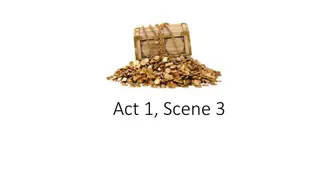Analysis of Act I Scene IV in Hamlet: Themes and Symbolism
Hamlet waits on the castle battlements for the ghost of the dead king to appear. Despite objections, he follows the ghost, setting a tone of nervous anticipation. The scene contrasts domestic and military settings, emphasizing urgency. The sound of cannon signals excessive drinking and partying at Claudius's court, angering Hamlet. Historically and literarily allusive, this scene highlights themes of betrayal, despair, and reputation deterioration.
Download Presentation

Please find below an Image/Link to download the presentation.
The content on the website is provided AS IS for your information and personal use only. It may not be sold, licensed, or shared on other websites without obtaining consent from the author.If you encounter any issues during the download, it is possible that the publisher has removed the file from their server.
You are allowed to download the files provided on this website for personal or commercial use, subject to the condition that they are used lawfully. All files are the property of their respective owners.
The content on the website is provided AS IS for your information and personal use only. It may not be sold, licensed, or shared on other websites without obtaining consent from the author.
E N D
Presentation Transcript
Act I scene IV Amjed Lateef Jabbar Ph.D. in English Literature Google Classroom (Elizabethan Drama) Class Code (52zj6rj)
SYNOPSIS Hamlet waits on the castle battlements for the ghost to appear. As Claudius s court drinks merrily within the castle, the ghost of the dead king reappears and beckons Hamlet to follow him. Hamlet does so, despite the objections of Horatio and Marcellus.
TIPS FOR ANALYSIS - The action in this scene returns to the cold battlements. Again, (as the contrast between scenes 1 & 2), Shakespeare contrasts neighboring scenes sharply, moving from a domestic scene to a military watch. - The lateness of the hour and the cold make an anticipation that the ghost is uncomfortable and his message is more urgent. - The mood is one of nervous anticipation as Hamlet, Horatio, and Marcellus wait for the appearance of the ghost.
At the beginning of this scene, there is an exchange in speech between Horatio and Marcellus. The functions of this exchange are: 1. to set a specific tone or mood. 2. to describe what is happening on stage without the use of stage directions. 3. so, now the audience knows that the time is late at night, that the place is cold, and that the men are anxious.
--- In the middle of the speech exchange between Horatio & Marcellus, the characters and the audience hear the sound of canon: --- This cannon does not signal danger; the artillery sound is merely the signal for the court to gather for drinking and partying. We develop an idea of the luxurious excesses of Claudius s court, although Hamlet remarks that excessive drinking is a stereotypical trait of the Danes.
This act of heavy drinking while in party, and Claudiuss actions in this scene tell us the following: 1. This act of the Danes is a reference (historical allusion) to the Vikings, and also a reference (literary allusion) to the Old English poem (Beowulf) and the concepts of the COMRADES and MEADHALL. 2. It adds to Hamlet s anger and despair of his uncle s happiness and festivity in spite of the very recent death of his brother the king. 3. Hamlet disgusts such activities generally because he thinks that they deteriorate the reputation even of good characters.
In the middle of this scene, Hamlet left the main event and action, and he started to contemplate about the nature of goodness. In literature, this device is called (DIGRESSION). While reading a play, a reader comes across several sudden interruptions in the main action of the play, which: 1. provides him background information, 2. establish his interest, 3. describes a character s motivation, and 4. builds suspense. These interruptions are called digressions. A digression is a stylistic device playwrights employ to create a temporary departure from the main subject of the scene, to focus on apparently unrelated topics, explaining background details. However, after this temporary shift, dramatists return to the main topic at the end of the event.
This digression here inAct I, Scene IV, serves the following aims: 1. It leads Hamlet to wonder about the nature of man and why some particular fault or another can destroy or corrupt an otherwise good person. 2. Hamlet seeks truth, and these kinds of thoughts reveal his tendency to infer conclusions from his observations. 3. It also tells us that Hamlet frequently moves from the specific to the general.
The spirit comes again! 1. Horatio sees the spirit first and announces its presence to the others. 2. Hamlet whispers a prayer, but he does not seem to fear any possible danger. He rushes forward impulsively to speak to the ghost, a figure he recognizes and calls, King, father; royal Dane (45). 3. In his speech with the ghost, Hamlet used powerful, mighty BLANK VERSE (the style which was introduced to English drama by Marlowe, and then developed by Shakespeare). 4. Hamlet asked the ghost why is he leaving his grave and show them sights that the living cannot possibly understand?
The ghost beckons Hamlet to follow him. Hamlet decided to follow the ghost despite the possible dangers and in spite of the warnings and preventions from Horatio and Marcellus. The reasons behind this are: 1. This may be the only chance he will ever have to connect with his father again. 2. The ghost may be able to answer Hamlet s questions and put his mind at ease about his irritating feelings that something is horribly wrong. 3. Hamlet considers this ghost to be a part of his destiny; nothing will prevent him from following it.
When Hamlet decided did not listen to the warnings of Horatio and Marcellus, they decided (at the end of this scene) to follow him. The reason behind this is: The Vikings (historical allusion), from whom the Danes descended, had a spirit of comradeship that these men seem to have inherited. No Viking would ever leave his lord to face danger and possible death alone. This deep-rooted understanding among the soldiers makes it impossible for the men to abandon Hamlet. They refuse to follow orders, preferring to stay close to the prince and protect him, if possible.























